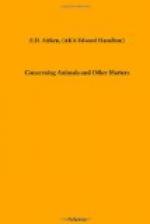This was followed in 1889 by Behind the Bungalow, which describes with charming insight the strange manners and customs of our Indian domestic servants. The witty and yet kindly way in which their excellencies and defects are touched off is delightful, and many a harassed mem-sahib must bless Eha for showing her the humorous and human side of her life surrounded as it is by those necessary but annoying inhabitants of the Godowns behind the bungalow. A tenth edition of this book was published in 1911.
The Naturalist on the Prowl was brought out in 1894, and a third edition was published in 1905. It contains sketches on the same lines as those in The Tribes, but deals more with the jungles, and not so much with the immediate surroundings of the bungalow. The very smell of the country is in these chapters, and will vividly recall memories to those who know the country along the West Coast of India southward of Bombay.
In 1900 was published The Common Birds of Bombay, which contains descriptions of the ordinary birds one sees about the bungalow or in the country. As is well said by the writer of the obituary notice in the Journal of the Bombay Natural History Society, Eha “had a special genius for seizing the striking and characteristic points in the appearance and behaviour of individual species and a happy knack of translating them into print so as to render his descriptions unmistakable. He looked upon all creatures in the proper way, as if each had a soul and character of its own. He loved them all, and was unwilling to hurt any of them.” These characteristics are well shown in this book, for one is able to recognise the birds easily from some prominent feature described therein.[1]
The Five Windows of the Soul, published by John Murray in 1898, is of quite another character from the above, and was regarded by its author with great affection as the best of his books. It is certainly a wonderfully self-revealing book, and full of the most beautiful thoughts. A second impression appeared in the following year, and a new and cheaper edition has just been published. The portrait of Eha is reproduced from one taken in 1902 in a flat on the Apollo Bunder, and shows the man as he was in workaday life in Bombay. The humorous and kindly look is, I think, well brought out, and will stir pleasant memories in all who knew Mr. Aitken.
W. B. B.
MADRAS, January 1914.
FOOTNOTES:
[Footnote 1: The illustrations are his own work, but the blocks having been produced in India, they do not do justice to the extreme delicacy of workmanship and fine perception of detail which characterise the originals, as all who have been privileged to see these will agree.]




